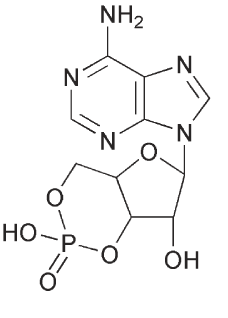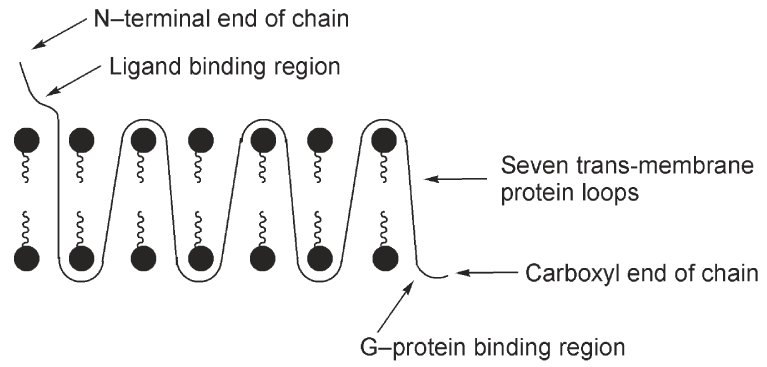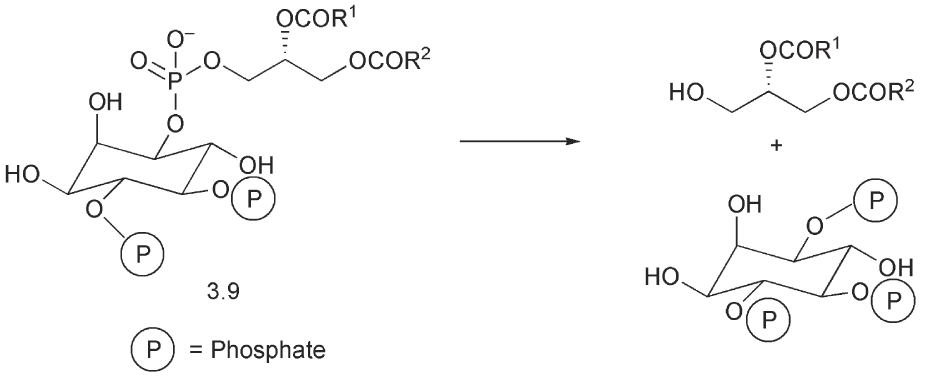


 علم الكيمياء
علم الكيمياء 
 الكيمياء التحليلية
الكيمياء التحليلية 
 الكيمياء الحياتية
الكيمياء الحياتية 
 الكيمياء العضوية
الكيمياء العضوية 
 الكيمياء الفيزيائية
الكيمياء الفيزيائية
 الكيمياء اللاعضوية
الكيمياء اللاعضوية 
 مواضيع اخرى في الكيمياء
مواضيع اخرى في الكيمياء
 الكيمياء الصناعية
الكيمياء الصناعية |
Read More
Date: 4-10-2017
Date: 29-3-2016
Date: 9-10-2017
|
G-PROTEIN-LINKED RECEPTORS
A large family of receptors are G-protein-linked receptors. These receptors contain seven trans-membrane protein loops (see Scheme 1). When a chemical messenger binds to these proteins it can initiate a sequence of events. The change in shape of the trans-membrane protein allows a Gprotein from within the cell to bind to part of the trans-membrane protein within the cell. The G-protein releases a guanine diphosphate and picks up a guanine triphosphate, hence the name G-protein. This change then causes the G-protein to dissociate into three sub-units (a, b and g). The a sub-units bring about various changes that depend on their structure (see Scheme 2). One sub-unit initiates the formation of cAMP 3.8 from adenosine triphosphate, ATP. Cyclic AMP behaves as a second messenger activating protein kinase A and thence a further sequence of enzymatic reactions (see Scheme 2). Another a sub-unit from a different G-protein activates the enzyme phospholipase C. This enzyme system hydrolyses phosphatidyl inositol diphosphate 3.9 to inositol triphosphate and diacylglycerol (see Scheme 1). The inositol triphosphate mobilizes calcium ions, which in turn affect muscle contraction and cardiac activity. The diacylglycerol activates protein kinase C, which in turn phosphorylates various enzymes involved in the inflammatory response and in tumour propagation.

3.8

Scheme 1 Schematic diagram of a G-protein-coupled (linked) receptor


Scheme 1 The action of phospholipase C
The individual ligands bind to different pockets in these G proteincoupled trans-membrane proteins. Many of the adrenergic receptors that respond to noradrenalin (norepinephrine) and adrenalin (epinephrine) and dopaminergic receptors belong to this family. Most of the serotonin receptors and the muscarinic sub-set of the cholinergic receptors also belong to this family.
The role of this chemical intervention in cell signalling is both to amplify the signal from the nerve and also, because the total amount of the neurotransmitter is limited, to regulate the information by preventing an overload.
There are significant differences in the time-scale over which these cellsignalling events take place. Effects arising from changes to an ionchannel are very rapid and may occur in milliseconds. Effects involving a trans-membrane protein and the initiation of a limited cascade of further enzymatic changes within the cell may occur in fractions of a second to a second. Finally, effects arising from binding of a cell signalling substance to a nuclear receptor and which involve the expression of a nucleic acid fragment in protein synthesis and enzyme actionmay take minutes to hours to occur.



|
|
|
|
لخفض ضغط الدم.. دراسة تحدد "تمارين مهمة"
|
|
|
|
|
|
|
طال انتظارها.. ميزة جديدة من "واتساب" تعزز الخصوصية
|
|
|
|
|
|
|
مشاتل الكفيل تزيّن مجمّع أبي الفضل العبّاس (عليه السلام) بالورد استعدادًا لحفل التخرج المركزي
|
|
|